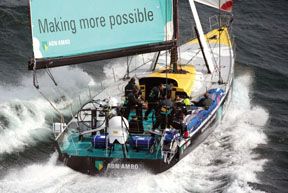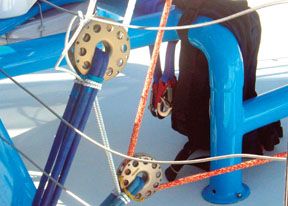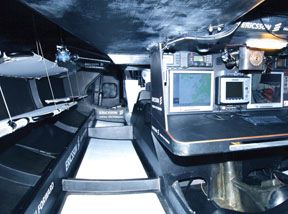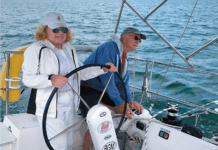This special report was filed by Practical Sailor Editor-at-Large Nick Nicholson, who is a member of the Rule Management Group for the Volvo Ocean Race. The RMG wrote, interpreted, and enforced the VO 70 Rule, with input from the world’s best sailors, yacht designers, and marine engineers. Nicholson also built a boat—Calypso—in his backyard, and sailed it around the world.
———-
288
When Volvo Event Management asked a group of yacht designers and rule makers to come up with a new class of offshore racing yachts for a race around the world via the great capes, the design brief was simple, but full of potential contradictions: Create the fastest offshore monohulls ever built, but make them easy to handle by a small crew, inexpensive to build, and safe. The boats should be capable of setting a new 24-hour monohull sailing record on any given day, and of shattering the record for elapsed time at sea for a race around the world.
The motto of the Volvo Ocean Race was to be “Life at the Extreme.” As the old saying goes: “Be careful what you wish for, because you just might get it.”
Every one of the Volvo 70s in the 2005-2006 Volvo Ocean Race had 24-hour runs in excess of 500 nautical miles, and not just on isolated occasions. Three boats—Movistar, ABN Amro One, and ABN Amro Two—set 24-hour monohull records, with ABN Two recording a run of over 560 nautical miles, averaging over 23 knots.
The Volvo Ocean Race featured all the drama—not all of it good—that a Hollywood scriptwriter could ask for: clashes of powerful personalities, smashed speed records, boats constantly on the edge of failure, and incredible acts of seamanship and sportsmanship. It also, unfortunately, cost one sailor his life, and resulted in the abandonment of one boat at sea.
Creating a 70-footer with a speed potential approaching that of a multihull is no small task. Multihulls derive much of their speed from a big power-to-weight ratio. Their ability to carry sail derives from their broad beam, rather than from ballast. Without ballast, a boat can be that much lighter, which translates into a higher speed potential.
Think of the performance of a 50 horsepower motorcycle weighing 400 pounds, compared to the performance of a 50-horsepower Volkswagen Beetle. That’s the result of the power-to-weight ratio, not just the raw horsepower available.
Traditional monohulls derive stability—and therefore the ability to carry sail in a breeze—from a ballast package suspended under the boat to counteract the heeling moment generated by the sails. Unfortunately, a ballast package suspended on centerline is a relatively inefficient way to create stability, particularly when reaching or sailing upwind.
With fixed ballast, you can increase stability by increasing the weight of ballast, or by increasing the effective lever arm of the ballast by increasing draft. Both of these approaches, however, can cause engineering problems with the design of the boat, requiring more structure—and more weight—to carry the loads. Extra weight reduces the power to weight ratio, and you get trapped in a cycle of tradeoffs that limit potential performance. On top of that, the engineering and construction demands of the extremes of this type of design can be breathtakingly expensive.
The perfect example of this is the America’s Cup Class. Stability translates into upwind power, which is the key to success in the America’s Cup. With draft fixed by the rules, the only way to increase stability is to increase the weight of the bulb. On the current generation of America’s Cup boats, over 80 percent of the boat’s total weight of 24 metric tons lies in the big ballast bulb, with precious little left over for the hull, deck, rig, and hardware. Clearly, these types of numbers are not suited for a boat meant to sail off the wind around the world in extreme conditions.
America’s Cup boats race in protected waters, with tenders never more than a few hundred yards away to rescue a man overboard or pick up the crew from a sinking boat. The quest to get weight into the bulb has resulted in spectacular failure, most notably the breaking in half and sinking of One Australia, and the breaking in half of Young America.
The good thing about a well-designed fixed-ballast monohull is that all the weight in the keel makes the boat resistant to capsizing, and fairly unstable in the inverted position once capsized. A capsized, fixed ballast monohull has a strong tendency to right itself.
288
Multihulls, on the other hand, have great stability and power at low angles of heel, but capsize relatively easily if overpowered. Once capsized, a multihull with its rig intact is more stable upside down than rightside up. Self-rescue is not practical on a big, oceangoing racing multihull.
The solution to this dilemma: a can’ting-keel monohull, the Volvo Open 70.
Canting keel monohulls offer the self-rescuing characteristic of a conventional monohull, while the variable lever arm of the can’ting keel can create far greater stability for a given weight of ballast, when compared to a conventionally ballasted monohull.
Canting keel monohulls are not new, but they are well out of the mainstream. For the Volvo Ocean Race, however, the can’ting keel monohull was the obvious solution.
The final solution was a can’ting keel boat of about 70 feet, 6 inches of both overall length and waterline length, with a dry weight of about 31,000 pounds, and a fully loaded sailing weight of about 38,000 pounds. With a mainsail of 1,900 square feet and masthead spinnakers approaching 5,000 square feet, this was going to be one powerful beast. In fact, the boats are so powerful that this is the first time I have ever seen sailmakers back off from making spinnakers of absolute maximum size for a racing boat.
Fast? Yes. Easy to handle? No. Inexpensive? Not really. Safe? In much the same way that snake-handling might be considered safe: only in the hands of an expert!
Unfortunately, the first generation of almost any new racing class is less than perfect, and VO 70s are no exception. Even with the additional righting moment of the can’ting keel, there are huge performance gains to be made by getting every possible pound out of the boat and into the bulb. All non-essential structure is removed, and what remains is pared to the absolute limit.
Calculating the required amount of structure for a high-performance sailboat is an inexact science. No one, to the best of our knowledge, can perfectly model the dynamic loads on a lightweight sailboat pushing down the face of a 20-foot wave at 35 knots. We tend to think of the greatest loads occurring when a boat is pounding upwind. In fact, the loads when a boat launches itself off a wave at high speed going downwind dwarf the upwind loads.
There is an old adage that goes: “sailing upwind, the crew will break before the boat; sailing downwind, the boat will break before the crew.” The Volvo Ocean Race proved this.
There was a huge hue and cry when two VO 70s returned to port with major damage on the very first night of the race in November 2005, with calls to abandon the race before boats were lost and sailors died. The cries were not silenced when boats continued to suffer serious damage throughout the race, much of it related to the can’ting keel mechanisms and the closing plates on the bottom of the hull around the keels.
There were also several incidents of core shear failure in the forward lower sections of hulls, as well as cracking in forward frames and bulkheads. Where the relatively flexible hull panels—they can deflect several inches under dynamic loads—were supported by rigid hull structure, the resulting stress risers caused local failures on a number of occasions, although none of these put the boats at significant risk.
The boat that seemed most plagued by problems was the Spanish yacht Movistar. The Farr-designed Movistar showed itself to be astonishingly quick in a breeze, and set a new 24-hour record while on its delivery run from Australia to Europe prior to the race. But it also suffered repeated problems with the closing structure surrounding the keel’s attachment point to the hull, as well as failures of the hydraulic keel rams and bits of internal structure.
The Movistar crew, in fact, were very wary of their high-strung thoroughbred’s bad habits. Much like a racing car that shows great speed but has a tendency to fly off the course in the corners, Movistar was constantly tweaked to try to maintain speed while increasing reliability.
Ultimately, the effort failed. When a major part of the main keel support broke in the North Atlantic—and with a major gale looming—Movistar was finally abandoned, its crew rescued by ABN Amro Two.
288
While none of us involved in creating the Volvo Open 70 rule could foresee all of the problems that would arise, we were concerned about the safety of the boats and crews from the very beginning. The Volvo 70s are divided into multiple watertight compartments to keep the boat afloat in the event of major damage. This was tested on several occasions, primarily aboard Movistar and Pirates of the Caribbean. We also required backup manual mechanisms to operate the can’ting keel in the event of failure of the primary powered keel system.
Most dramatic from the public perspective is the requirement that the boat be capsized—fully inverted—with at least two of the crew inside, who were then required to right the boat solely by shifting the keel position with the manual backup system. No one looked forward to this test, but in retrospect, it was one of the best requirements of the rule, although no boat ever had to do this at sea.
The Notice of Race specified the most complete array of safety equipment ever assembled for an ocean race. The safety section of that Notice of Race should be required reading for anyone contemplating offshore sailing, whether racing or cruising. You can read it at www.volvooceanrace.org/.
But even the best safety equipment is wasted if you don’t use it, and a sailor aboard ABN Amro Two proved that when he lost his life during the difficult trans-Atlantic leg.
The superbly organized ABN Amro One program dominated the 2005-2006 Volvo Ocean Race, wrapping up victory with two legs left to sail. The only second-generation boat in the fleet, the Juan Kouyoumdjian design was a powerful reaching boat with excellent all-around performance. Mike “Moose” Sanderson, ABN One’s skipper, asked for the fastest boat in the world reaching with 15 knots of wind, and Kouyoumdjian gave it to him.
Incidentally, Sanderson is also a superb sailmaker. He was a sailmaker at North Sails New Zealand back in 2000, and created a suit of sails for our boat, Calypso, that we used for 20,000 miles from New Zealand back to the U.S. We never had a single repair to those sails, and our boat’s performance and balance improved dramatically thanks to Sanderson’s careful eye. Some guys can just do anything aboard a boat.
So does the average sailor gain from the extreme experience of the Volvo Ocean Race? You bet he does. These boats are sailed shorthanded, with only four crew on deck most of the time. The resulting advances in sailhandling, including spinnaker snuffers, spinnaker furlers, and efficient mainsail reefing, are critical for all shorthanded sailors. Lightweight, reliable deck hardware developed for the race has a place on any boat. With tight limits on the number of sails that can be built, versatility and durability of sails determine how much horsepower is available throughout the race. If easy-to-handle, versatile sails are important to you, the Volvo Ocean Race is important to you.
The 2005-2006 Volvo Ocean Race met the sponsor’s demand for a test of “Life at the Extreme.” It was perhaps too extreme for many, but so is driving in a NASCAR race or climbing Mount Everest. That’s a good way to think of it: Racing a VO 70 around the world is sort of like driving a NASCAR car to the top of Everest: Put the challenge out there, and someone will take it on, while the rest of us watch in amazement.









































